1. Overview
Virtual Network Computing (VNC) is a protocol commonly used to share a graphical desktop over a network. Popular uses for VNC include technical support and screen sharing.
By default, Ubuntu comes with Remmina remote desktop client with support for VNC and RDP protocols. We will use it to access remote server.
What you’ll need
- A computer running Ubuntu 16.04 LTS or above
- A running VNC server
- Remmina Remote Desktop Client installed
Installing Remmina
If you don’t have Remmina on your Ubuntu installation, install it with sudo apt install remmina remmina-plugin-vnc. You can also use snap package (sudo snap install remmina).
Originally authored by Marcin Mikołajczak.
2. Launch Remmina
Remmina’s user-interface is easy to use. A quick connection can be made from the entry field beneath the toolbar by switching from the RDP to the VNC protocol, entering the address of your VNC server and clicking “Connect !”. But for convenience, it’s far better to create a re-usable connection, which we’ll cover in the next step.

3. Add a connection
Click on “New” to open the “Remote Desktop Preference” pane. The following details should be configured:
- Server: The IP address and port of the VNC server you wish to connect to. For example, 192.168.1.2:5901
- User name: Not necessary unless your server is using VNC users.
- Password: If your server uses a password, enter it here. If not entered and your server requires a password, you’ll be able to enter it after starting the connection.
- Colour depth: Choose 24-bit for a fast connection, such as across a LAN, or 256 colours when using a low bandwidth connection.
- Quality: Provides more control over bandwidth and rendering quality, with “Poor” trades visual quality for responsiveness, while “Best” does the opposite.

Click “Save” when you’re happy with the connection. Now, let’s connect to our VNC!
4. Connecting to the server
Connect to the VNC server by selecting your server profile and clicking “connect”.

In toolbar, you have options to switch to fullscreen mode, change view and graphics quality.

5. That’s all!
Easy, wasn’t it?
Congratulations! You have successfully used Remmina to connect to a VNC server, allowing you to remotely access your machine or potentially provide some technical support to someone sharing theirs.
If you need more guidance on using VNC client, help is always at hand:
- Ubuntu Discourse
- Ask Ubuntu
- IRC-based support
Further readings
- Remmina Wiki page
Was this tutorial useful?
Thank you for your feedback.
Время на прочтение10 мин
Количество просмотров305K
Создавая виртуальный сервер на VPS.house, вы получаете полностью 100% готовую к использованию операционную систему Windows Server, к которому сразу же можно подключаться по сети с любого внешнего устройства по протолку RDP.
RDP (Remote Desktop Protocol) – специальный протокол, разработанный компанией Microsoft для удаленного управления ОС Windows (протокол удалённого рабочего стола). Изначально, разумеется, как и многие вещи под Windows, этот протокол разработали другие люди, но в настоящее время поддерживает его и развивает Microsoft.
Согласно условиям лицензирования, ОС Windows Server допускает по умолчанию не более 2-х одновременных подключений по RDP к серверу, если нужно больше, то понимается терминальный сервер и лицензируется либо количество пользователей, либо количество подключаемых устройств. Но, подключившись к серверу по RDP, вы также можете поставить любое удобное вам решение для удалённого управления рабочим столом: TeamViewer, RAdmin и прочие.
Данная статья описывает процесс подключения к серверу Windows по RDP с многих популярных операционных систем. Ввиду этого получилась она довольно длинной. Моментально перейти к нужному вам разделу вы можете по этому меню:
Подключение в VPS серверу из десктопной Windows
Данная инструкция проверена и работает успешно на всех популярных версиях Windows для персональных компьютеров: XP, Vista, Windows 7, 8, 8.1 и 10.
В каждой операционной системе Windows есть встроенное приложение для подключения по RDP – это программа «Подключение к удалённому рабочему столу» (Remote Desktop Connection в англоязычных ОС).
Для запуска ее зайдите по пути:
Пуск -> Программы -> Стандартные -> Подключение к удалённому рабочему столу
Если вы используете Windows 8, тогда:
Пуск -> Приложения -> Подключение к удалённому рабочему столу
Если вы используете Windows 10, тогда:
Пуск -> Все приложения (может этого пункта не быть!) -> Стандартные Windows -> Подключение к удалённому рабочему столу
Или же просто нажмите комбинацию клавиш Win+R и в открывшемся окне наберите mstsc

В открывшемся окне наберите IP-адрес вашего виртуального сервера и нажмите кнопку «Подключить». IP-адрес сервера вы можете видеть в вашем личном кабинете в разделе «Мои серверы»:


Если вы заказали сервер с 2-я или большим количеством IP-адресов, то для подключения к серверу вы можете использовать любой из них – это ни на что не влияет.
Те, кто впервые стакиваются с созданием удалённого рабочего стола, часто задаются вопросом «Зачем нужны эти IP-адреса и сколько нужно именно им», часто также путают количество IP-адресов с количеством рабочих столов или учётных записей, или полагают, что если зайти на сервер по одному адресу, то открывая браузер именно этот адрес будет браузер использовать. Нас самом же деле это всего лишь список внешних адресов, по которому можно подключиться к серверу, сама работа на сервере уже после подключения никаким образом не меняется.
Чаща всего при подключении по умолчанию настроена автоматическая передача данных из буфера обмена, а также подключаются к серверу и становятся на нём видны локальные диски устройства, с которого вы подключаетесь. При сразу после нажатия на кнопку «Подключить» вы можете увидеть уведомление о возможном вреде, который может нанести как удалённый компьютер вашему, так и ваш удалённому. Такое вполне возможно если вы подключаетесь к чужому серверу, на котором могут быть вирусы или вы подключаетесь к своему проведенному серверу с чужого заражённого ПК.
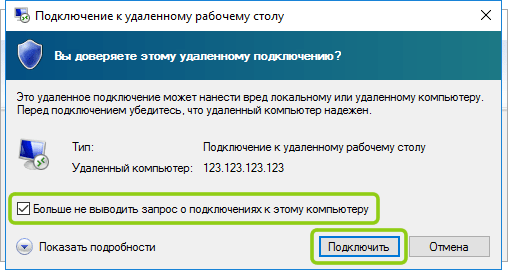
Подключаясь к только что созданному и чистому серверу можно смело отключить дальнейшие уведомления и продолжить процесс подключения.
Далее вы увидите окно с вводом авторизационных данных:
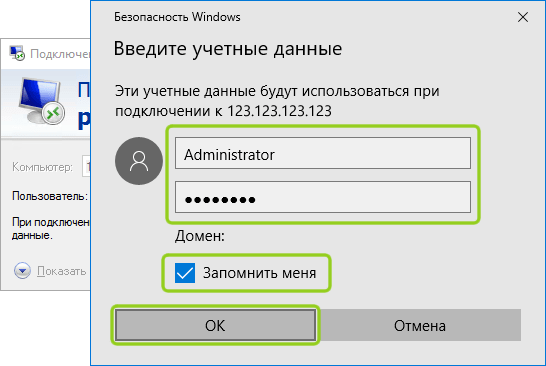
При создании каждого нового сервера система VPS.house автоматически генерирует новый уникальный пароль для него, при этом на всех серверах Windows по умолчанию остаётся имя пользователя Administrator. Пароль от сервера отображается также в личном кабинете возле вашего сервера на странице «Мои серверы»:

В целях безопасности, по умолчанию пароль от сервера скрыт и отображается только по нажатию на ссылку «Показать пароль», при этом сайт попросит вас ввести пароль от вашей учётной записи на VPS.house.
Обратите, пожалуйста, внимание на то, что очень часто при попытке подключения с Windows 7 если копировать и вставлять пароль, система показывает ошибку о неверно введённых учетных данных, тоже самое может возникать и в других версиях. Если вы с этим столкнулись, просто
введите пароль вручную
и обязательно с учётом регистра (заглавные буквы вводите заглавными, а строчные строчными и строго в английской раскладке клавиатуры).
После успешной авторизации перед началом сессии вы получите уведомление о неуспешной проверке подлинности удаленного компьютера. Причина этого уведомления в том, что сессия на стороне сервера шифруется по умолчанию с помощью SSL-сертификата, который сгенерировал сам же сервер, а не тем, что мог быть выдан авторизованным центром сертификации.

Данное уведомление не говорит о проблемах безопасности, и вы смело можете отключить его для будущих подключений к этому же серверу, отметив галочкой «Больше не выводить запрос о подключениях к этому компьютеру».
Если вы используете для работы Windows XP и при подключении система выдает ошибку с текстом «Удаленный компьютер требует проверку подлинности на уровне сети, которую данный компьютер не поддерживает», значит на ваш ПК очень сильно устарел и нужно дополнительно установить небольшое обновление, где его взять и как установить
мы подробно расписали здесь
.
Встроенная программа подключения к удалённому рабочему столу позволяет с лёгкостью передавать файлы на сервер, копируя их на вашем ПК и вставляя в любую папку уже на самом сервере и наоборот. Помимо этого, можно включить передачу на сервер практически любых USB-устройств и сетевых принтеров и сканеров.
Для включения этих возможностей перед подключением к серверу нажмите на кнопку «Показать параметры»:

Откроется режим расширенных настроек подключения к вашему VDS серверу. Перейдите на вкладку «Локальные ресурсы» и отметьте галочкой требуемые для вас устройства:

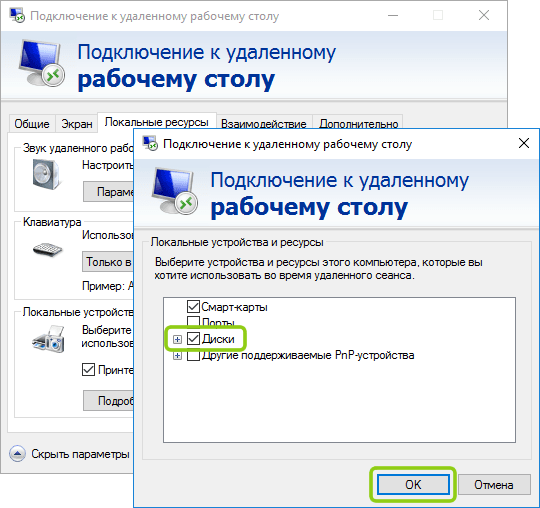
Еще одна очень полезная и популярная функция – это возможность создать готовый файл подключения (так называемый «ярлык»), в котором уже сохранены все нужные вам настройки и данные авторизации на сервере. Это особенно удобно если вы хотите дать доступ сотруднику, который не является опытным пользователем ПК.

Для этого также в расширенных настройках подключения на вкладке «Общие» введите имя пользователя (на серверах VPS.house это всегда по умолчанию Administrator), отметьте галочкой «Разрешить мне сохранять учетные данные», чтобы не приходилось вводить пароль каждый раз и, по завершению внесения всех нужных вам остальных параметров подключения (если таковые есть), нажиме кнопку «Сохранить как»:

В итоге вы получите готовый файл с подключением, который вы можете отправить вашему коллеге и тот в свою очередь подключится к серверу 2-я простыми кликами по нему мышкой.
В целях безопасности по умолчанию в данный файл не будет добавлен пароль от учётной записи, он будет запрошен при первом подключении.
Как подключиться к серверу по RDP если вы работаете с Ubuntu
Протокол подключения к уделённому рабочему столу Windows (RDP) – это закрытый протокол компании Microsoft, официальных служб под операционные системы Linux Microsoft не выпускает, но так или иначе уже давно существуют стабильно работающие решения, которые в последних редакциях Ubuntu даже включены в изначальную сборку.
Речи идет о клиенте под названием Remmina
По умолчанию если Remmina включена в вашу сборку, вы можете найти ее в Поиске по запросу «Remote Desktop Client», если ее нет, то установите ее при помощи следующих команд в Терминале.
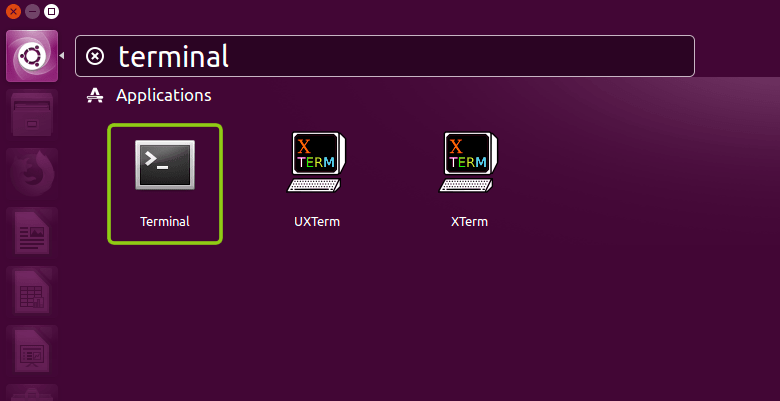
- Устанавливаем пакет Remmina
sudo apt-add-repository ppa:remmina-ppa-team/remmina-next - Устанавливаем обновления
sudo apt-get update - Устанавливаем плагин протокола RDP
sudo apt-get install remmina remmina-plugin-rdp libfreerdp-plugins-standard - Если ранее у вас уже была установлена какая-либо версия Remmina или была запущена до установки, то ее необходимо перезапустить. Это лучше всего сделать перезагрузкой компьютера или с помощью команды:
udo killall remminaЕсли после её выполнения вы получили сообщение об ошибке типа «процесс не найден», значит и так все хорошо и можно было команду и не выполнять.
В меню поиска наберите «remote desktop» или «remmina», чтобы найти установленное приложение:
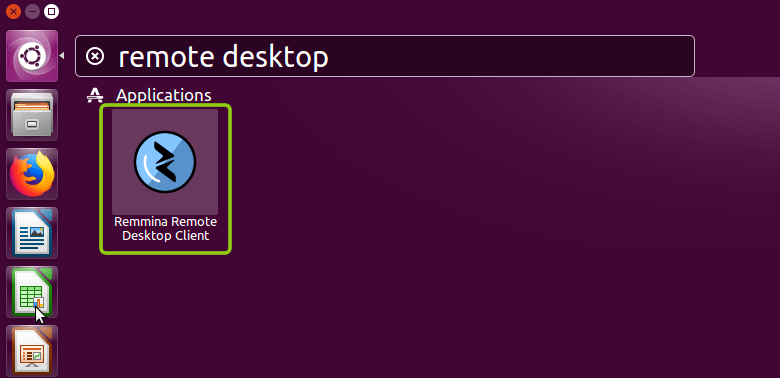
Remmina позволяет добавлять и сохранять список подключений для быстрого доступа к тому или иному серверу. Для сознания нового нажмите на «+», как показано на изображении:

Заполните поля авторизационными данными, которые
указаны в вашем личном кабинете
:
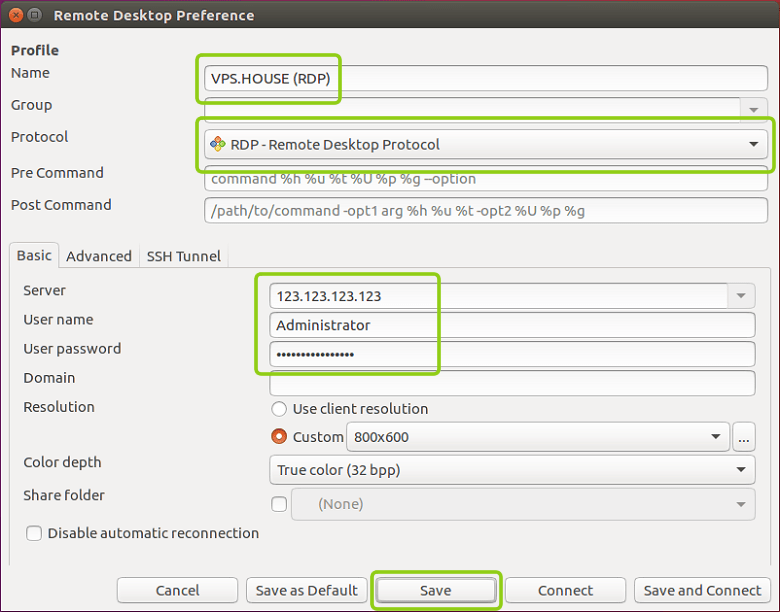
На вкладке «Advanced» вы можете также указать качество подключения к серверу и детализации при передаче изображений:
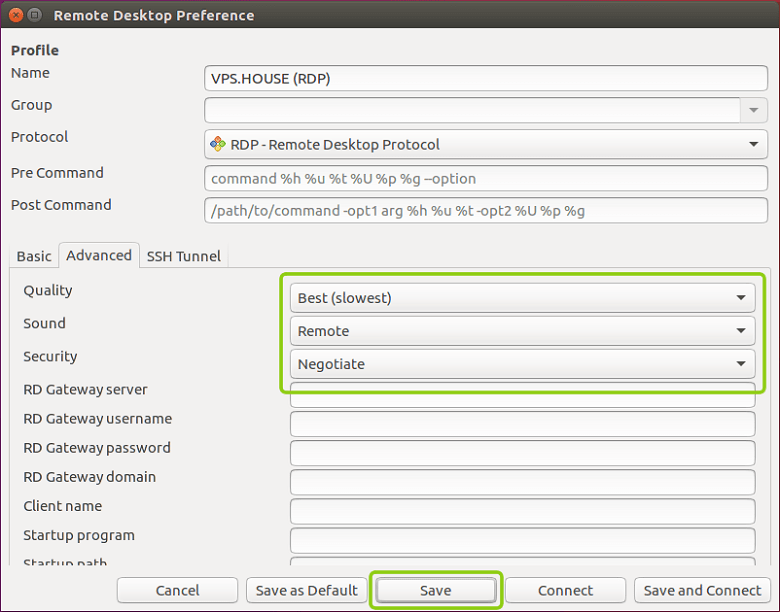
После сохранения данных вы всегда сможете найти ваш сервер в списке подключений Remmina. Для подключения к серверу теперь достаточно просто кликнуть дважды мышкой по строке сервера:

Если вы подключаетесь к серверу впервые с этого приложения, то оно может показать информацию о ошибке в сертификате безопасности. Почему это происходит
мы описали выше в блоке подключения к серверу из десктопной Windows
.
Достаточно нажать «ОК» и программа продолжит подключение к вашему серверу:
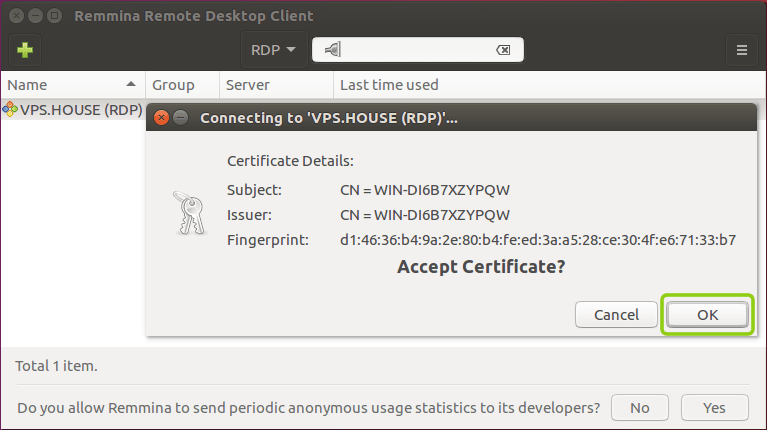

Как подключиться к серверу по RDP если вы работаете с Debian
Протокол RDP (Remote Desktop Protocol) – это закрытый протокол удалённого рабочего стола Microsoft. К сожалению, они не выпускают официальных клиентов для работы подключения к серверам Windows с операционных систем, работающих на базе Linux. Однако уже довольно давно существуют стабильно работающие решения.
Одно из самых популярных – это клиент для всевозможных удалённых Remmina, именно его мы и рекомендуем использовать для включения к серверам VPS.house или любым другим под управлением ОС Windows.

- Указываем путь к установочным файлам
echo 'deb http://ftp.debian.org/debian stretch-backports main' | sudo tee --append /etc/apt/sources.list.d/stretch-backports.list >> /dev/null - Запускаем процесс установки
sudo apt update - Устанавливаем плагин протокола RDP
sudo apt install -t stretch-backports remmina remmina-plugin-rdp remmina-plugin-secret libfreerdp-plugins-standard
Сразу после установки приложение можно найти через поиск программ:

В отличие стандартного от RDP-клиента ОС Windows, Remmina позволяет сохранять в список все свои подключения к различным серверам и осуществлять моментальный доступ к ним. Для добавления первого сервера в список нажмите «+» в левом верхнем углу:

В открывшемся окне задайте параметры подключения к вашему серверу и введите удобное для запоминания имя сервера. Все необходимые для подключения данных указаны в вашем личном кабинете:

На вкладке «Advanced» («Дополнительные») вы можете задать параметры передачи звука с сервера на ваш ПК, а также качество передаваемого изображения при подключении:

После сохранения я настроек вы увидите новую строку в списке подключений. Для начала работы с сервером достаточно просто дважды кликнуть по нему мышкой:
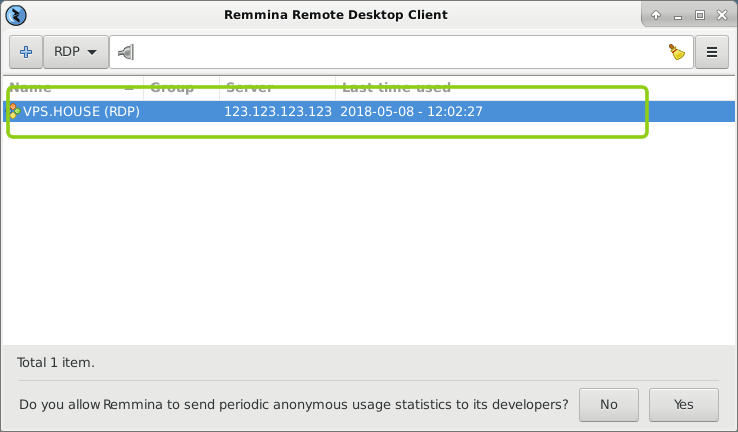
В момент первого подключения к серверу Remmina покажет уведомление у недоверенном сертификате шифрования. Это не является какой-либо ошибкой или проблемой безопасности. Причину этого сообщения мы описали выше. Просто нажмите «ОК» и вы увидите рабочий стол вашего сервера, при условии, разумеется, что все данные для подключения ранее были введены корректно.


Подключение серверу по RDP из Mac OS
Для подключения к удалённому рабочему столу для Mac OS компания Microsoft разработала и поддерживает официальный RDP-клиент. Он стабильно работает с любыми версиями ОС Windows.
Для загрузки его перейдите на сайт iTunes: https://itunes.apple.com/gb/app/id715768417
Программа обладает интуитивно понятным интерфейсом и позволяет создавать список серверов для дальнейшего моментального подключения к ним.
Для добавления нового сервера в список нажмите «New», как показано на скриншоте:
В открывшемся окне укажите авторизационные данные, как указано
в вашем личном кабинете
(IP-адрес сервера, логин Administrator и его пароль), и укажите произвольное название для нового подключения (Connection Name).
По завершению ввода нажмите на кнопку закрытия окна – все данных сохранятся и появится строчка с вашим сервером в списке подключений:

Кликните на эту строчку дважды мышкой, и вы подключитесь к серверу.
При попытке подключения к вашему VPS серверу если он работает на Windows Server 2008 или более новой версии, программа покажет уведомление о том, что не удалось проверить сертификат шифрования. Это не является проблемой безопасности, а всего лишь говорит о том, что сертификат выдан не сертифицированным центром, а сгенерирован самим же сервером.
Для того, чтобы это сообщение в будущем не возникало для этого сервера, нажмите «Показать сертификат».

Отметьте галочкой «Всегда доверять…» и нажмите «Continue».

Если в настройках подключения все параметры были введены без ошибок (IP-адрес, логин и пароль), то вы сразу же увидите рабочий стол вашего Windows Server:
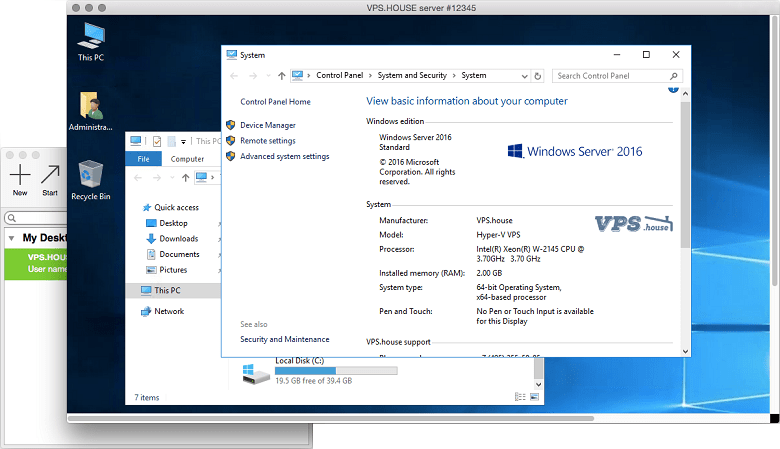
Подключение к VDS серверу со смартфона или планшета на iOS (с iPhone или iPad)
Для iOS копания Microsoft выпускает полноценный официальный RDP-клиент комфортного и стабильного подключения к удалённому рабочему столу. Приложение называется Microsoft Remote Desktop или Удаленный рабочий стол: https://itunes.apple.com/ru/app/id714464092
Microsoft Remote Desktop позволяет заранее настроить целый список используемых вами для частого подключения серверов.
Специфика его работы заключается в том, что информация об учётных записях создаётся и хранится отдельно от самого списка серверов. Соответственно, для начала нам требуется добавить учётную запись пользователя Administrator. Для этого нажмите на кнопку настроек (иконка шестерёнок в верхнем левом углу) и выберите «Учётные записи»:
В открывшемся окне нажмите на «Добавление учётной записи пользователя» и введите логин Administrator и его пароль, как отображается
в вашем личном кабинете
:
По завершению вы увидите, что учётная запись Administrator добавлена в список, далее нажмите кнопку «Готово» и вы вернетесь на стартовый экран.
Следующим шагом добавляется непосредственно информация о самом сервере. Нажмите кнопку «+» в правом верхнем углу приложения и в открывшемся меню выберите «Рабочий стол»:
В окне добавления нового подключения укажите IP-адрес вашего сервера и выдерите учётную запись Administrator, добавленную на прошлом шаге:
В момент первого подключения вы увидите уведомление вы увидите уведомление о недоверенном сертификате безопасности. Причину этого
мы описали выше
. Выдерите «Больше не спрашивать для этого ПК» и нажмите «Принять».

В случае если IP-адрес и авторотационные данные указаны без ошибки, вы успешно подключитесь к вашему виртуальному серверу:

Как подключиться к VPS серверу со смартфона или планшета на Android
Для устройств под управлением Android компания Microsoft выпускает полноценное приложение для работы с удалённым рабочим столом – Microsoft Remote Desktop. Скачайте его как любое другое приложение в
Google Play
.
В отличие от всех описанных выше приложений для подключений с ПК, мобильное приложение Microsoft Remote Desktop разделяет учётные записи и сам список подключений. Поэтому сначала нужно добавить в список учётную запись пользователя Administrator с его паролем, который показан
в вашем личном кабинете
:
После добавления учётной записи возвращайтесь на главный экран приложения для добавления самого подключения (адреса вашего VDS сервера):
В открывшемся окне укажите IP-адрес вашего сервера (указан в
личном кабинете
), выберите добавленную ранее учётную запись Administrator и нажмите «Сохранить» («Save»):
На главном экране в списке подключений появится ваш сервер, просто нажмите на него, и программа начтёт подключение. Если вы подключаетесь с этого приложения к серверу впервые, то увидите информационное сообщение о том, что приложению не удалось проверить сертификат шифрования. Почему так происходит
описано в начале статьи
.
Достаточно отметить галочкой «Never ask again for connections to this PC» и данное уведомление больше появляться не будет. Далее нажмите «Connect» и если все авторотационные данные и IP-адрес сервера указан без ошибок, вы успешно к нему подключитесь:

P.S.: У клиентов нашего VPS-хостинга часто возникает вопрос, как подключиться к серверу с того или иного устройства. В поисковиках можно найти все эти инструкции в том числе и с картинками, и с видео. Надеюсь, данная статья, будет полезной и здесь, как содержащая в одном месте инструкции по подключению со всех самых популярных устройств и операционных систем.
The Remote Desktop Protocol (RDP) allows users to connect to another computer across a network and take remote control over the host machine.
The remote desktop connection is possible between different platforms, e.g., Linux users are able to RDP into a Windows system and vice versa.
Learn how to RDP to a Windows PC from your Ubuntu system in minutes.
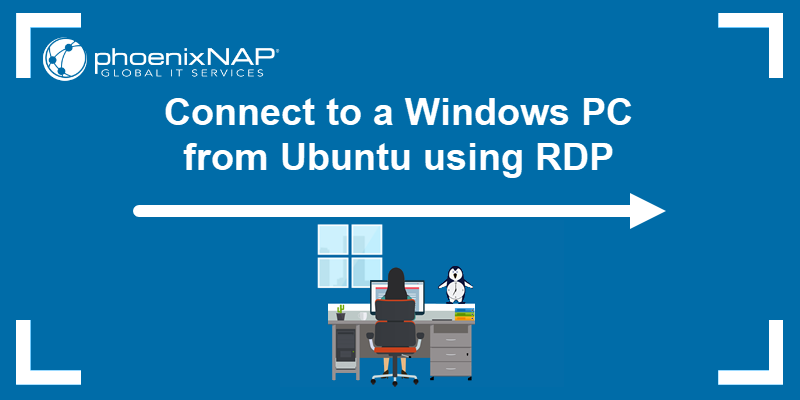
Prerequisites
- Ubuntu system.
- Sudo or root privileges.
- A remote Windows machine with network connectivity.
- Windows firewall set to allow incoming RDP connections.
- The user account intended for the RDP session with RDP permissions on the Windows system.
How to Connect to a Windows PC From Ubuntu
The Ubuntu (client) and Windows (host) systems must be configured before establishing an RDP connection. This configuration ensures the Windows system allows remote desktop connections and the Ubuntu client has the necessary software to initiate the connection securely.
Enable Remote Desktop Connection on the Windows Computer
Incoming RDP connections must be enabled on the Windows system. There are two ways to enable RDP in Windows.
Option 1: Enable RDP in Settings
To enable RDP in Windows settings, take the following steps:
1. Open the Windows Start menu and select Settings.
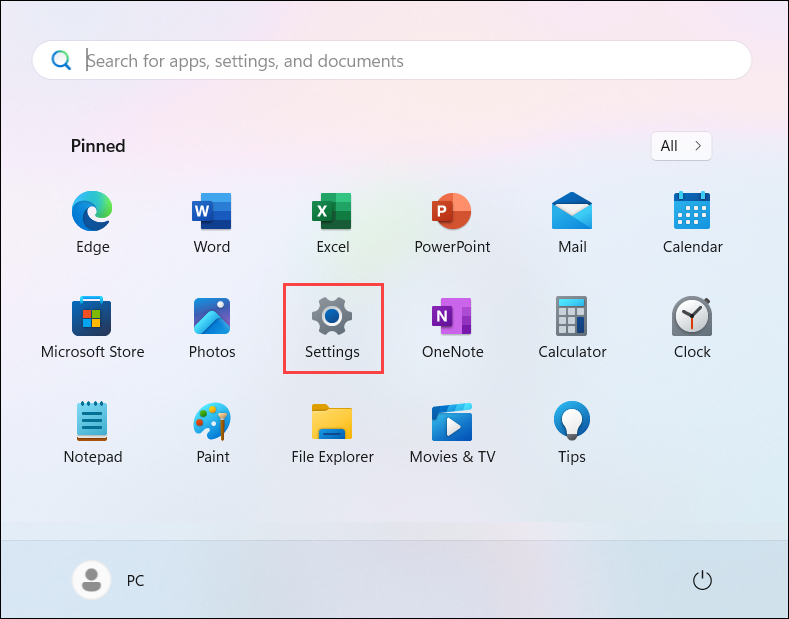
Note: Alternatively, press Winkey+I to access the Settings app.
2. Select System.
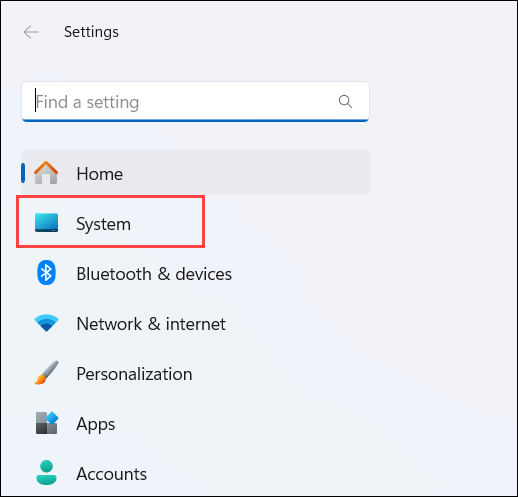
3. Scroll down and locate Remote Desktop in the menu.
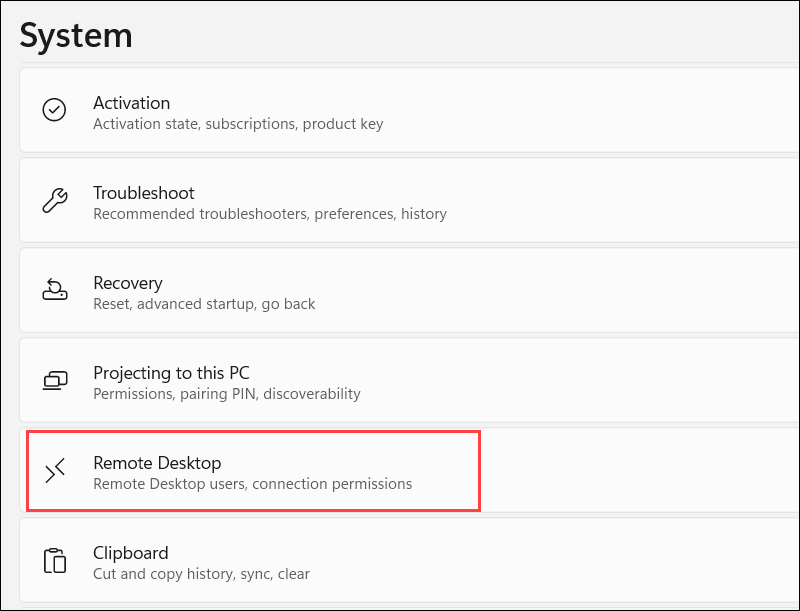
4. Toggle the Enable Remote Desktop switch On.
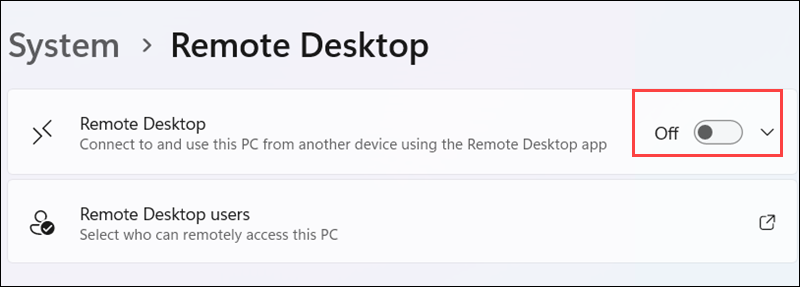
5. Click Confirm.

6. Close the Settings menu.
Note: When enabling RDP, ensure the user account initiating the connection has RDP permissions and the firewall allows RDP connections.
The Windows PC now accepts RDP connections.
Option 2: Enable RDP from Windows CMD
Activating RDP via the Windows Command Prompt (CMD) is useful when automating RDP setups across multiple Windows machines or creating scripts to streamline the configuration process.
To accomplish this, take the following steps:
1. Type cmd in the Windows search box.
2. Select Run as administrator to open the Command Prompt with administrative privileges.
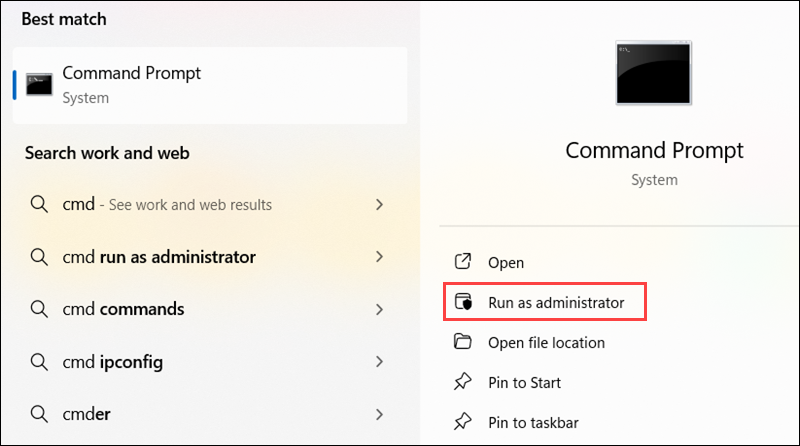
3. The reg command modifies the Windows Registry. Enter the following command to enable RDP:
reg add "HKEY_LOCAL_MACHINE\SYSTEM\CurrentControlSet\Control\Terminal Server" /v fDenyTSConnections /t REG_DWORD /d 0 /f
Warning: Exercise caution when making changes to the Windows Registry. Incorrect modifications harm your system.
4. This part is optional, but if the Windows Firewall is activated, use the following command to enable RDP connections:
netsh advfirewall firewall set rule group="remote desktop" new enable=Yes
Note: The user account used to establish the connection must have RDP permissions on the Windows machine, and the Windows firewall must allow RDP connections.
The Windows system is ready to accept RDP connections.
Install Desktop/GUI Environment on Ubuntu (Optional)
Users running Ubuntu Server or a minimal installation of Ubuntu without a graphical user interface (GUI) often use command-line-based RDP clients, such as FreeRDP. However, some RDP clients like Remmina do not work without a GUI.
Installing a GUI on Ubuntu, such as Ubuntu GNOME, KDE Plasma, LXDE, or XFCE, provides a more intuitive and user-friendly environment for establishing RDP connections.
To install the GNOME desktop environment:
1. Update the Ubuntu packages list:
sudo apt update2. Enter the following command to install GNOME:
sudo apt install ubuntu-desktop -y3. Reboot the system:
sudo rebootOnce you log in to the Ubuntu system, you are presented with a desktop environment.

Next, install and launch your preferred RDP client to connect to the Windows system.
Install Remote Desktop Client Software on Ubuntu
Linux users utilize RDP clients such as Remmina, FreeRDP, or others to facilitate an RDP connection.
The following text presents how to install remote desktop client software on Ubuntu.
Option 1: Install Remmina Client on Ubuntu
Remmina is the default RDP client on newer Ubuntu systems. To check if the Remmina client is installed, use dpkg piped with grep:
dpkg -l | grep remmina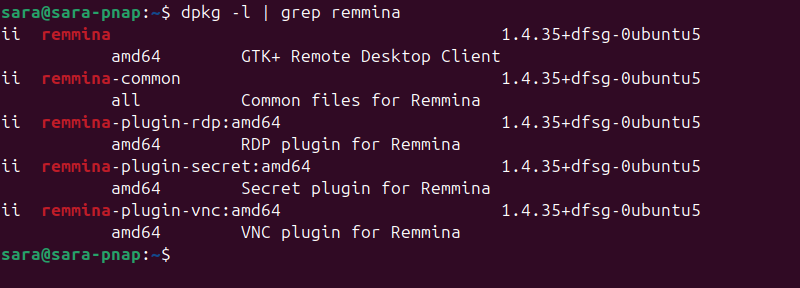
The system displays a list of installed Remmina packages and plugins. If the Remmina client is not installed, take the following steps:
1. Update the Ubuntu packages list:
sudo apt update2. Install Remmina and the necessary plugins:
sudo apt install remmina remmina-plugin-rdp -y
3. Launch the RDP client by entering the following command:
sudo remmina4. Click the top left + icon to add a new connection profile.
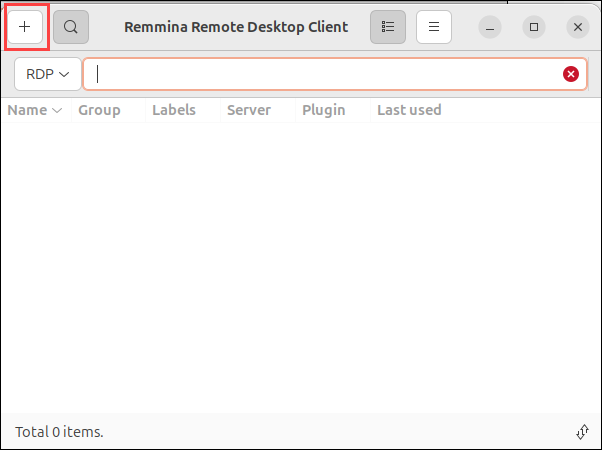
5. Enter a connection profile Name. For example, Windows PC Connect.

6. Select RDP — Remote Desktop Protocol from the Protocol dropdown menu.

7. Enter the IP address or hostname of the Windows machine in the Server field.
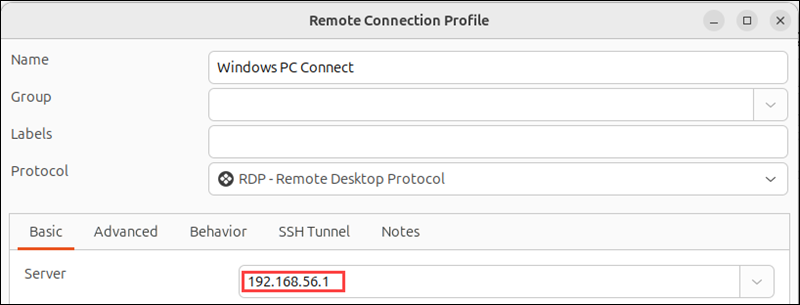
Note: Find the IP address of the Windows machine using the ipconfig command. Look for the IPv4 Address under your active network connection.
8. Define the username and password for the user account you plan to use to log into the Windows machine.
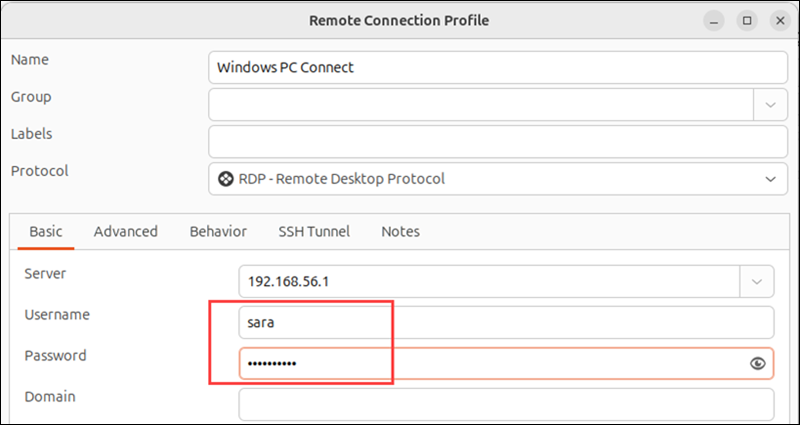
Note: This user should be granted RDP permissions on the Windows host.
9. Select Use client resolution or define a custom resolution in the Resolution field.
10. Leave the Colour depth set to Automatic. This preference allows the server to choose the best format based on network speed.
These are the mandatory options for initiating a standard RDP session. The Remmina client has numerous advanced settings to customize how the RDP connection is established.
11. Click Save and Connect to save the profile and connect to the Windows machine using the profile details.
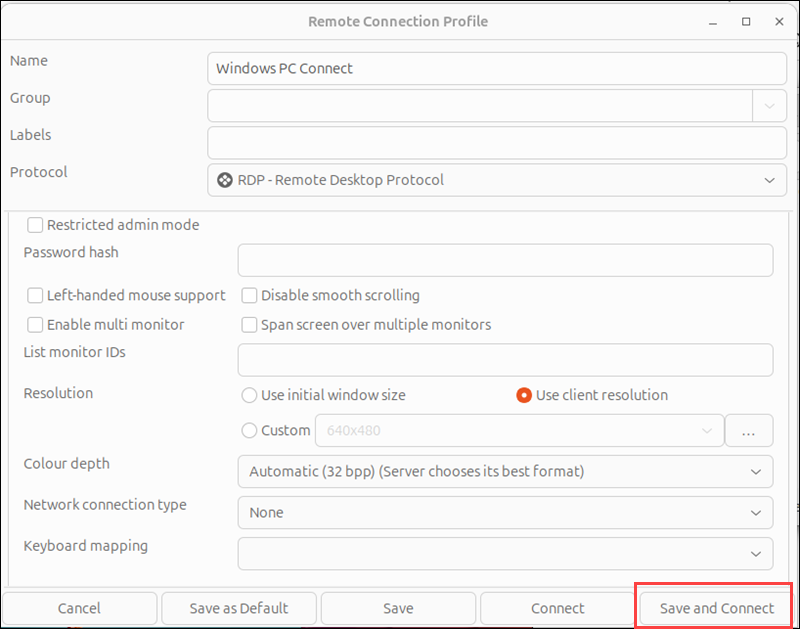
Note: If you receive a certificate warning, opt to trust the (legitimate) certificate to continue with the connection.
The remote Windows desktop is available in the Remmina dashboard.
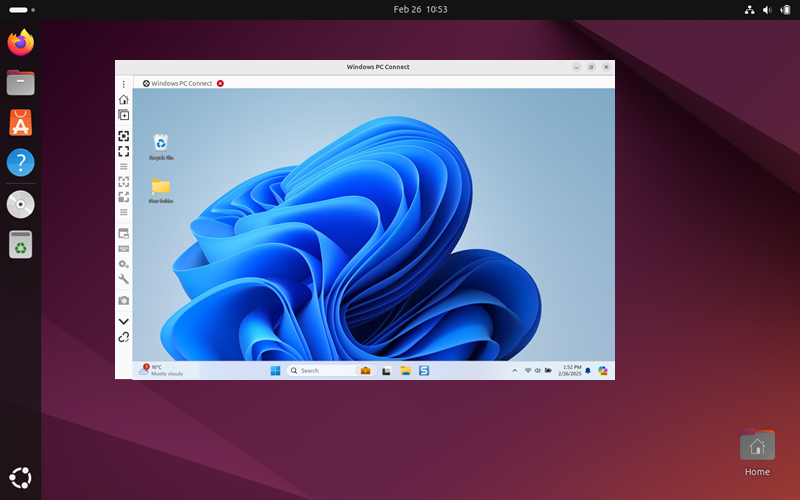
The next time to RDP into the Windows system, launch Remmina and double-click the saved profile.
Option 2: Install FreeRDP Client on Ubuntu
FreeRDP is an open-source Remote Desktop Protocol (RDP) client that allows Ubuntu to connect to Windows using the terminal. It is often preferred over graphical clients like Remmina for its flexibility, lower resource usage, and ability to be scripted for automation or remote administration.
To install the FreeRDP client on Ubuntu:
1. Update the Ubuntu packages list:
sudo apt update2. Install the FreeRDP client using the following command:
sudo apt install freerdp2-x11 -y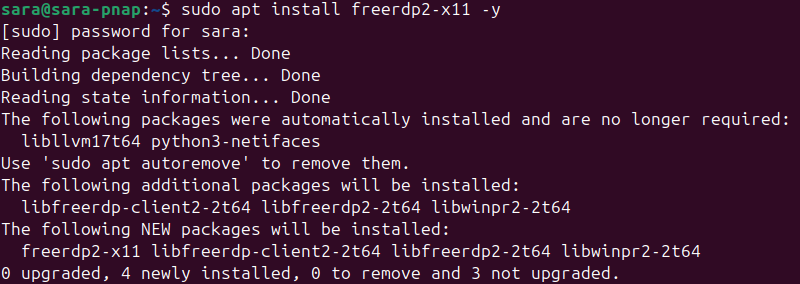
3. Establish the RDP connection using the following syntax:
sudo xfreerdp /v:windows_machine_ip /u:usernameReplace windows_machine_ip and username with valid connection details. In this example, those are:
sudo xfreerdp /v:192.168.56.1 /u:PCIf the password /p: option is not included in the command, xfreerdp prompts for the RDP user password. This practice is more secure than entering the password within the command.
Note: To find the windows_machine_ip, run the ipconfig command. Moreover, to find username, run echo %USERNAME% in the command prompt.
Once connected via FreeRDP, the user gains access to the remote Windows system in a graphical interface.
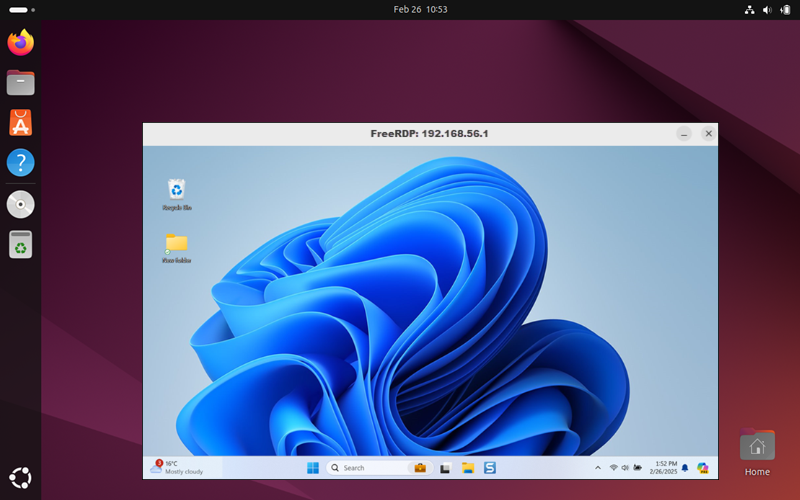
The xfreerdp command-line tool is part of the FreeRDP project and offers multiple options for connecting to RDP servers:
| OPTION | DESCRIPTION |
|---|---|
/p:[password] |
Specifies the user’s password. |
/domain:[yourdomain] |
Specifies the domain for authentication. |
/f |
Enables fullscreen mode. |
/size:[1366x768] |
Specifies a custom screen resolution. |
/port:[4309] |
Specifies a port number other than the default 3389. |
Ubuntu RDP to Windows: Extra Tips + Best Practices
To ensure a secure Remote Desktop Protocol (RDP) connection from Ubuntu to Windows, carefully consider performance and security settings. By optimizing hardware, network speed, and display settings, users enhance responsiveness and reduce lag during remote sessions.
The sections below offer advice on how to achieve optimal results when connecting to Windows using RDP on Ubuntu.
Minimum vs. Optimal Hardware Requirements
The RDP experience depends on bandwidth, network latency, and the capabilities of the Windows host machine. The table below outlines the minimal and optimal requirements for the Ubuntu and Windows systems:
| Hardware | Ubuntu Client Minimal / Optimal |
Windows Host Minimal / Optimal |
|---|---|---|
| CPU | Dual-core processor / Multi-core processor | 1 GHz dual-core / 2.4 GHz+ multi-core |
| RAM | 2 GB / 4 GB+ | 4 GB / 8 GB+ (16 GB+ for heavy tasks) |
| Graphics | Integrated GPU / Dedicated GPU (for graphics-intensive tasks) | DirectX 12-compatible GPU / Dedicated GPU for demanding applications |
| Network | 5 Mbps / 20 Mbps+ | 5 Mbps+ / 20 Mbps+ |
| Disk | Sufficient memory for RDP client software / SSD | 64 GB storage (minimum) / SSD highly recommended |
Use the information in the table as a broad guideline. Actual requirements depend on the specific tasks performed during the RDP session.
Implement Security Measures
To enhance the security of an RDP session from Linux to Windows, implement security measures on the Windows side, Linux side, and the network. The lists below offer useful tips for each security segment.
Windows
- Limit the number of user accounts that can establish an RDP connection.
- Create dedicated accounts for RDP to restrict access to critical systems or data.
- Enforce strong password policies for RDP user accounts.
- Implement two-factor authentication (2FA) for RDP sessions.
- Activate Network Level Authentication (NLA) to require authentication before establishing a session.
- Temporarily lockout user accounts after multiple unsuccessful login attempts.
The network
- Use a firewall to restrict RDP access to specific IP addresses.
- Change the default RDP port (3389) to a non-standard port number to mitigate brute-force attacks.
- Use a VPN to encrypt the data transfer between client and host machines.
- Alternatively, use SSH port forwarding to create an encrypted tunnel for the RDP session if a VPN is not an option.
Linux
- Regularly update the RDP Client to the latest version to benefit from security patches and improvements.
- Disconnect from an RDP session when it is not being used and set timeouts for idle sessions.
- Limit the number of simultaneous active sessions.
Ideal Internet Speed for RDP Connections
RDP is efficient even over slower connections. However, specific tasks require a minimal level of visual quality and responsiveness.
The table offers an overview of minimal and recommended bandwidth for general RDP tasks:
| Task | Minimum Bandwidth | Recommended Bandwidth |
|---|---|---|
| Text-based tasks | 1 Mbps | 2 — 5 Mbps |
| MS Office and Web browsing | 3 — 5 Mbps | 10 — 15 Mbps |
| Design, images, and video | 10 — 15 Mbps | 25 — 50 Mbps+ |
| Concurrent RDP Sessions | Allocate bandwidth for each concurrent session. | Allocate bandwidth for each concurrent session. |
Keep in mind that apart from bandwidth, server loads, network latency, and stability affect RDP performance.
Test the RDP performance under typical work conditions and adjust RDP and network settings to balance responsiveness and quality.
Reduce Resolution and Color Depth for Performance Boost
Controlling the amount of detail an RDP client transfers over the network produces significant performance gains. Read the sections below to learn how to adjust resolution and color depth in your RDP session.
Reducing the Resolution of an RDP Session
Lowering the screen resolution or window size in RDP sessions means fewer pixels are transferred over the network. This strategy improves responsiveness and speed when bandwidth is limited.
RDP clients enable users to set the screen resolution when initiating an RDP session. For instance, with FreeRDP, use the following command to set a 1280×720 resolution:
sudo xfreerdp /v:windows_machine_ip /u:username /size:1280x720Reducing the resolution enhances speed but also compromises visual quality.
Lowering Color Depth of an RDP Session
Color depth defines how sharply a system represents or distinguishes unique colors.
Lowering the color depth reduces the amount of data transmitted for each pixel. The session is more responsive, but colors may seem off, and gradients might lose their smoothness.
In the Remmina client, the Color depth option lets users define the color depth for the RDP session.
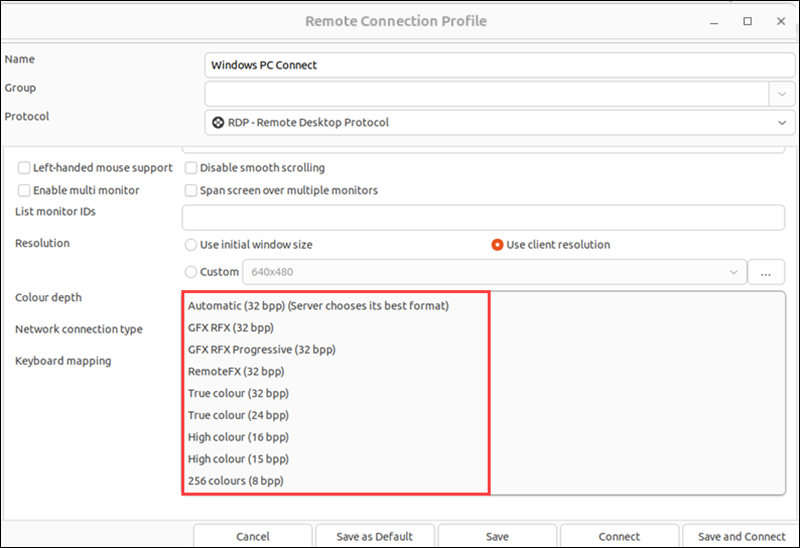
A low depth works for simple tasks like text editing, but the True color setting, with 32 bits per pixel, provides the high-quality visuals required for video playback or graphic design.
Conclusion
This article explained how to use an RDP client to connect to a remote Windows PC from your Ubuntu system. Use this tool to administer remote Windows systems, provide technical support to Windows users, and operate Windows-specific tools and applications.
Next, learn how to access an Ubuntu PC via Remote Desktop from Windows.
Was this article helpful?
YesNo
Remote desktop allows you to manage your system remotely. It accesses your files, applications, and settings from anywhere. This is useful for system administrators who need to perform maintenance tasks and developers who want to work on their projects from different locations. Enabling remote desktops allows you to ensure seamless connectivity and control over your Ubuntu machine.
In this tutorial, we will demonstrate the step-by-step instructions to enable the Ubuntu remote desktop.
Enabling Ubuntu Remote Desktop
Enabling Ubuntu Remote Desktop allows you to access and control your system remotely, making it easier to troubleshoot issues, collaborate with others, and maintain your system without being physically present.
To enable the Ubuntu remote desktop, follow the below steps:
Step 1: Update Ubuntu Repository
Before diving into the setup, it is always a good practice to ensure the Ubuntu system is up to date:
sudo apt update
It updates the Ubuntu package lists and upgrades all installed packages to their most recent versions:
Step 2: Install Remote Desktop Software
Ubuntu comes with built-in support for remote desktop access using VNC (Virtual Network Computing). However, you might need to install additional software to enhance functionality. One popular choice is xrdp. It allows you to use the Remote Desktop Protocol (RDP) to connect to your Ubuntu machine.
To install xrdp, run the following command:
sudo apt install xrdp
Once the installation is done, you can start the xrdp service with the following command:
sudo systemctl start xrdp
To enable XRDP, run the command below:
sudo systemctl enable xrdp
Step 3: Configure Remote Desktop Settings
Next, you need to configure the remote desktop settings. To do so, open the “Settings” application on the Ubuntu machine and navigate to the “System” section. Then, press the “Remote Desktop” option:
It navigates to the new window. Here, toggle the “Desktop Sharing” and “Remote Control” switches. They enable you to allow remote control of your screen:
In the “Desktop Sharing” settings, you can configure various options, such as allowing connections only from users with a password and setting a password for remote access.
Enable Remote Desktop with Ultahost Ubuntu VPS
Use Ultahost’s VPS hosting for optimal performance and control when enabling a remote desktop on Ubuntu, ensuring seamless access and reliable uptime.
Step 4: Configure Firewall Settings
If you have a firewall enabled on your Ubuntu machine, you need to allow incoming connections for the remote desktop service. By default, xrdp uses port 3389. To allow connections on this port, execute the below command:
sudo ufw allow 3389/tcp
It opens port 3389 for TCP connections and allows remote desktop clients to connect to your machine:
To enable the Ubuntu remote desktop, you must know the machine’s IP address. For this, use the below command:
ip a
Finally, log out from the machine after all configuration:
Step 5: Connect to Your Ubuntu Machine
Once the configuration is set up, you can now connect to your Ubuntu machine from another computer. If you are using a Windows machine, you can use the built-in Remote Desktop Connection application. After launching, simply enter the IP address of your Ubuntu machine:
Now, you need to enter the credentials such as username and password:
Finally, you access the Ubuntu Remote Desktop and verify the IP address from Settings:
Conclusion
Enabling Ubuntu Remote Desktop provides a convenient way to manage your system remotely, whether you’re troubleshooting issues, collaborating with others, or performing maintenance tasks. By following the simple steps outlined in this tutorial, you can easily set up remote desktop access using tools like XRDP and configure necessary firewall settings. This setup ensures seamless connectivity and control over your Ubuntu machine from anywhere, making it a powerful solution for system administrators and developers alike.
We hope this guide has helped you successfully enable Ubuntu Remote Desktop. Consider Ultahost’s RDP VPS Server Hosting for seamless, secure, and cost-effective remote access to your system from anywhere in the world, ensuring reliable performance and full control at your fingertips.
FAQ
Why should I enable the Ubuntu remote desktop from terminal access?
Enabling remote desktop access allows you to manage your system, assist others, or access your machine from anywhere, enhancing productivity and flexibility.
How do I find the IP address of my Ubuntu machine for remote access?
You can find your IP address by running the command ip a in the terminal. Use this IP address when connecting remotely from another device.
What software do I need to install for remote desktop access on Ubuntu?
You can install XRDP, which allows you to use the Remote Desktop Protocol (RDP) to connect to your Ubuntu machine.
How do I allow remote desktop connections through the firewall?
If you have a firewall enabled, run the command sudo ufw allow 3389/tcp to open port 3389 for TCP connections, allowing remote desktop clients to connect.
How to connect to a Ubuntu machine from a Windows computer?
To connect to Ubuntu, utilize the pre-installed Remote Desktop Connection app on Windows.
What should I do if I encounter issues with remote desktop access?
Ensure that the xrdp service is running, the firewall is configured correctly, and the remote desktop settings are properly set. Check for any error messages and consult the official Ubuntu documentation for further assistance.
Is it safe to enable remote desktop access on Ubuntu system?
Yes, it can be safe if you follow best practices such as using strong passwords, enabling encryption, and keeping your system updated. Always monitor your system for any unauthorized access attempts.
Last Updated :
20 Feb, 2024
systemRemote Desktop from Windows helps to access a different operating system in Windows itself. Windows & Ubuntu operating systems can be used simultaneously with the help of Remote Desktop Access. Remote Desktop Access on Ubuntu from the Windows process will be discussed in this article by following simple steps on both Ubuntu & Windows.

Table of Content
- Method 1: Get Remote Access Using Remote Desktop Protocol (RDP)
- Method 2: Get Remote Access Using Virtual Network Computing (VNC)
- Method 3: Get Remote Access Using Third-party Software
Why Do We Use a Remote Desktop Connection?
There are many situations where we require remote desktop access of a computer system. Some of the cases are mentioned below.
- Remote Access: Enables accessing a computer from anywhere.
- File Retrieval: Access files and documents remotely.
- Tech Support: IT support resolves issues without physical presence.
- Collaboration: Multiple users work on the same project simultaneously.
- Resource Utilization: Use powerful software/resources remotely, saving local device resources.
Pre-Requisite to Establish Remote Desktop Access.
Before establishing the Remote desktop access on Ubuntu, you need to meet a few requirements :
- Enable Port Forwarding on the remote device’s router
- Find Ubuntu’s IP Address
- Install SSH on the Ubuntu box.
Let’s see how to do this quickly!
Enable Port Forwarding:
To access a remote Access on another network (e.g., your work network), you need to Enable Port Forwarding on the router where your Ubuntu PC is located.
- Log into your router’s web interface using a web browser.
- Look for the port forwarding section or NAT settings.
- Create a new port forwarding rule for port 3389 (Remote Desktop’s default port).
- Enter the local IP address of your Ubuntu machine.
- Save the changes and restart the router if necessary to apply the configuration.
Find Ubuntu’s IP Address:
- Launch the Terminal application on your Ubuntu machine.
- Type ‘ ifconfig ‘ and press Enter to display network interface details.
- Look for the IPv4 address associated with the network interface you are using (like eth0 or en0).
Install SSH:
- Launch Terminal on your Ubuntu machine.
- Type ‘sudo apt-get update‘ to update package lists.
- Type ‘sudo apt-get install openssh-server‘ and press Enter.
- Complete the installation process and set up SSH on your Ubuntu system.
How to Set Up Remote Desktop Access From Windows to Ubuntu?
Once you are equipped with all the prerequisites to establish Remote Desktop Access. You are ready to move on and start the actual process of Set Up Remote Desktop Access From Windows to Ubuntu.
Method 1: Get Remote Access Using Remote Desktop Protocol (RDP)
On the Ubuntu Operating System
Step 1: To develop Remote Desktop from Windows, first open the terminal open a terminal (Ctrl + Alt + T) of Ubuntu & execute the following command in the terminal. It will help to install the XRDP application in Ubuntu that helps to combine different operating systems. It will take some time to install the application.
Command: sudo apt install xrdp -y
.png)
Step 2: After installation of the application, run the following two commands. One of the commands will help to start the application that is installed on the device. The second command will help to enable the application on the machine.
Commands:
sudo systemctl start xrdp
sudo systemctl enable xrdp

Step 3: After running the above commands, again execute the following command to show the status of the XRDP application. The status of the application is now running.
Command: sudo systemctl status xrdp
.png)
Step 4: At last, execute the following command in the Ubuntu terminal. It will provide configurational details of the machine. Find out the IP Address of the Ubuntu operating system.
Command: ifconfig
.png)
Hence, we have completed the operations required in the Ubuntu operating system.
On Windows Operating System
Step 1: To complete Remote Access Ubuntu from Windows, first open the Remote Desktop Connection in the Windows OS & provide the IP Address of the Ubuntu operating system. It will be the same operating system that was noted down earlier. After that, click on the Connect button.

Step 2: In the next tab, click on the Yes button present there to connect Ubuntu from Windows.
.png)
Step 3: Now provide the username & password. It will be the same username & password used to enter into the Windows operating system. If there is no password present in the Windows operating system, keep it blank here. Then click on OK to finish the operation.

Hence, we have completed the operations required to establish remote desktop access to Ubuntu From Windows
Method 2: Get Remote Access Using Virtual Network Computing (VNC)
Virtual Network Computing allows desktop sharing on computer network. So to connect your Windows to Ubuntu PC, follow these steps.
Step 1: Install VNC Server on Ubuntu:
- 1. Open Terminal and type ‘sudo apt-get update‘.
sudo apt-get update
- 2. Install the VNC server with ‘sudo apt-get install tightvncserver’.
sudo apt-get install tightvncserver
Step 2: Install VNC Viewer on Windows:
- Download and install a VNC Viewer application on your Windows computer.
Step 3: Start VNC Server on Ubuntu:
- Type ‘vncserver‘ in the Terminal and set a password.
vncserver
Step 4: Connect from Windows:
- Open VNC Viewer on Windows.
- Enter Ubuntu’s IP address and the password you set.
- Click Connect to establish remote access to Ubuntu from Windows.

Method 3: Get Remote Access Using Third-party Software
Remote desktop Software allows you to connect and get remote access on computer in another location. You can easily control a connected PC via an internet connection with 2 simple steps.
Step 1: Install Software on Ubuntu and Windows:
- Choose a tool like TeamViewer, NoMachine, or Chrome Remote Desktop
- Go to their official websites and download the software for both Ubuntu and Windows.
Step 2: Launch the Software and Connect:
- Open the software on both devices.
- Enter the partner’s ID (displayed on Ubuntu) in the Windows software.
- Click Connect to establish remote access from Windows to Ubuntu.
Just like this you can use any of the above-mentioned methods and can Set Up Remote Desktop Access from Windows to Ubuntu.
Also Read
- How to control your PC by your Smartphone?
- How do I use SSH to connect to a remote server in Linux?
- How to Run Linux Software on Windows — GeeksforGeeks
